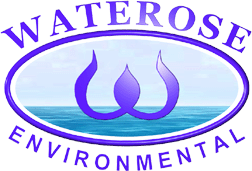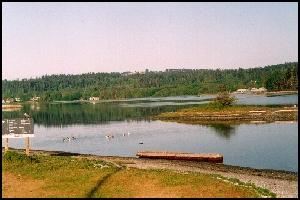 | ||||||
| Articles | Projects | Resume | Cartoons | Windsurfing | Paintings | Album |
Esquimalt Lagoon
State of the Ecosystem Report

Water Quality Analysis Project 1998
Waterose et. al.

Section 1. Introduction:
Overview:
An eight month study was conducted to assess various aspects of the Esquimalt Lagoon and the associated land use of Royal Roads University (RRU). The nature of this study was broad based, and focused on surface fresh water inputs to the Lagoon that originate or pass through RRU grounds. Levels of nitrates and fecal coliforms were analyzed. Fecal coliforms were found in fresh water bodies, and levels were below those acceptable for primary recreational contact which is an activity such as swimming. Levels of nitrates were generally near upper limits of guidelines for human health, and that of aquatic life. One sampling site, however, indicated levels roughly double that of the guidelines. Background research was performed on red tide events, geomorphology as well as present and historical land use. The compilation of the background research with the results of the in house analysis was used to draw conclusions and make recommendations for the management of RRU property, as well as for further study.
Introduction:
Royal Roads University (RRU) expressed concerns regarding water quality in Esquimalt Lagoon. Ongoing annual red tide events, fish kill, high levels of fecal coliforms and annual algae blooms have raised concerns regarding human health, as well as that of the Lagoon ecosystem. This report is in response to RRU’s request for a “State of the Ecosystem Report.” In considering the various possible ways of meeting this objective, two primary areas of focus were identified; a review of previous scientific reports, and a strategic study of fecal coliform and nutrient inputs into the Lagoon.
Scope and Objectives:
This project consisted of three phases. Phase one was the planning and conceptual stage, phase two was data collection and analysis, and phase three was preparation of the written report.The scope of the study involved two major components. A literature review was conducted to compile historic information about the historical and present land use as well as the geomorphology of the area, hydrology, red tide blooms, coliform levels, and, nutrient levels. This information has been integrated into the report. The second component involved the collection and statistical analysis of data regarding the levels of nitrates and fecal coliforms entering the Esquimalt Lagoon from the RRU property. This data was used to analyze the statistical relationships between sampling locations, levels of nitrates, numbers of fecal coliforms, and other parameters. In addition, this information helped to provide valuable data regarding any sources of contamination on RRU property which are potential ‘hot spots’.
This study integrates the research information with findings obtained during the study. The report provides important information for the sustainable management of the RRU land base. In addition, this information can provide the basis for an ongoing program of study.
To Section 2. History and Land Use
Index:
- Introduction
- History and Land Use
- Geomorphology
- Nutrients and Coliforms
- Red Tides and Fish Kill
- Hydrocarbons
- Sample Procedure
- Analysis Procedure
- Results
- Discussion
- Future Study
- References
- Photo Album


 email Waterose
email Waterose
Please Sign My Guestbook
Please View My Guestbook

| Articles | Projects | Resume | Cartoons | Windsurfing | Paintings | Album |
 | ||||||